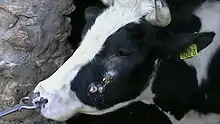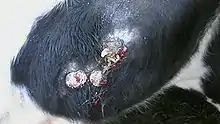Actinomycosis in animals
Actinomycosis can be categorized in three separate ways, when it is a moveable tumour or lump on the jaw area it is referred to as lump jaw, when it spreads into the hard bone of the jaw it is referred to as big jaw and when it affects the tongue it is referred to as wooden tongue. Although all three have different names and areas of infection, they are all caused by the same buildup of bacteria.[1]



Actinomycosis in cattle
It is a common condition in weaned calves, young bulls, and heifers. The disease has a chronic course, and the general condition can remain quite good.
There is a swelling of the maxilla and mandible. Fistulisation occurs after some days, leaving a thick, yellowish, non-odorous pus, with mineralised, 2 to 5 mm (0.079 to 0.197 in) grains therein.
Later on, a granuloma will form in the place of fistulisation.
The bony lesions are followed by periostitis, with permanent deformation of the facial bones.
Other parts of the body other than the mouth area can be infected by actinomyces. It has been seen that the actinomyces can cause lesions in the intestinal tract, lungs and liver as well. This is a very rare occurrence but it has happened. The diagnosis of the actinomycotic lesions in internal organs can only be diagnosed post-mortem.[1]
Causes
There are different ways to contract actinomycosis. Sometimes it is through the infection of simple injuries and wounds but more often infections are caused by a bactera known as Actinomyces or ray fungus.[1] The bacteria that infects the animal is known as ray fungus for its radiating characteristics of the bacteria itself.[2] It grows best outside the animal and the infection is most likely an accident; the animal may have consumed the bacteria from a number of different forages or grains.[1] For this reason, the spread of the disease is not from animal to animal but it is likely that the whole herd will contract it as they would be grazing on the same area.
Control
To control the spread of the disease, affected animals should be isolated or sent for slaughter. The herd should be rotated to a new grazing area to reduce the chances of further infection.[3]
Treatment
The affected areas are treated with iodine solutions. A common method to achieve this is to give the cattle sodium iodide orally on a regular treatment schedule. Antibiotics such as Tetracyclines are also used. These two treatment methods can be used alone or together; simultaneous use is considered more aggressive. Killing the bacteria that cause the infection is the ultimately purpose of these treatment methods. However, they are seldom effective unless treatment is started very early.[4][5]
It is notable that surgery is not typically considered for treatment of cattle as it is in extreme human cases.[6]
Prevention
There are no real preventions for reducing the contraction of actinomycosis as it is difficult to destroy all the fungi in a pasture.[1]
Misdiagnosis
As is often the case, there are diseases/conditions with signs and symptoms that are similar to actinomycosis. As such, misdiagnoses can occur. Some examples include abscesses caused by grass seeds, woody tongue, bottle jaw, cancerous growths, and irritation caused by lodged objects.[4]
Other species affected
Although actinomycosis is more common in cattle it can also be found in other species such as horses, sheep, swine, dogs, deer and also humans.[1] In humans the infection is usually caused by A. israelii.[6]
References
| Wikimedia Commons has media related to Actinomyces bovis. |
- Connaway, J. W.; Uren, A. W. "Actinomycosis (Lump Jaw, Big Jaw and Wooden Tongue) in Cattle". University of Missouri College of Agriculture Agricultural Experiment Station (357). hdl:10355/54507. Retrieved 8 April 2019.
- Sullivan, Donna C.; Chapman, Stanley W. (2010-05-15). "Bacteria That Masquerade as Fungi". Proceedings of the American Thoracic Society. 7 (3): 216–221. doi:10.1513/pats.200907-077AL. ISSN 1546-3222. PMID 20463251.
- "Lumpy jaw and wooden tongue in cattle". www.dpi.nsw.gov.au. 2017. Retrieved 2019-04-01.
- Roche, M. (2015). "Lumpy jaw".
- Smith, G.W. (2013). "Overview of Actinomycosis". The Merck Veterinary Manual.
- Okulicz, J.F. (2016). "Actinomycosis Treatment & Management".